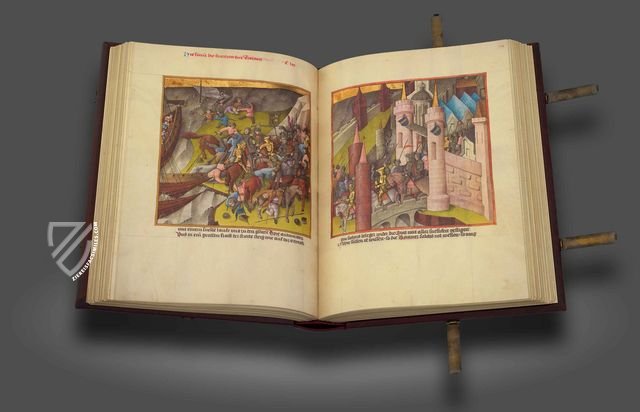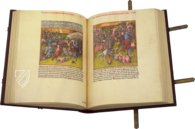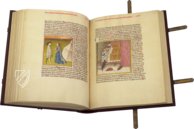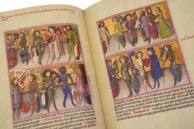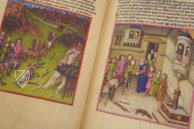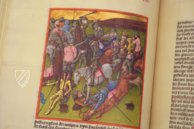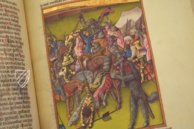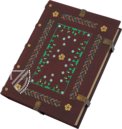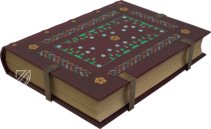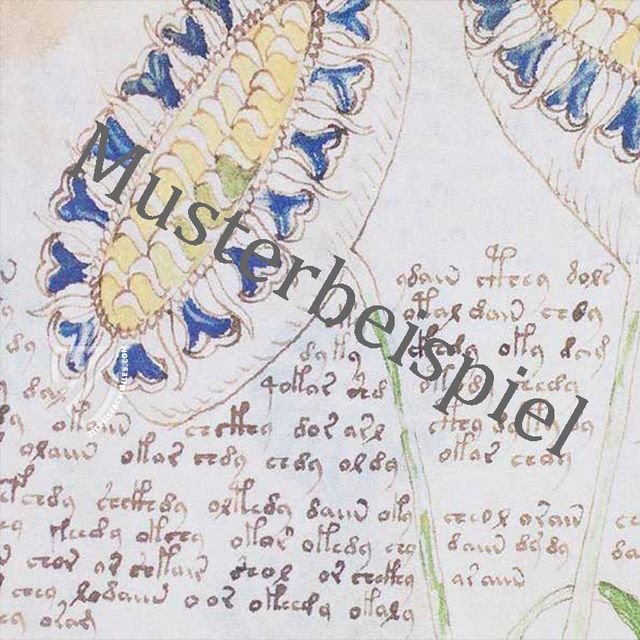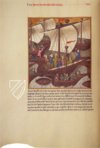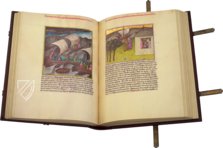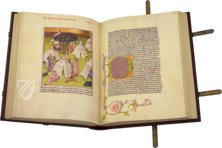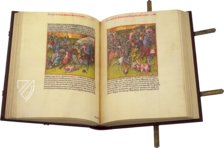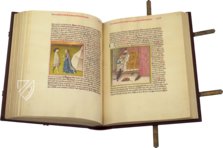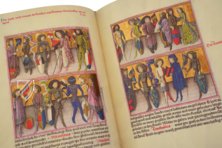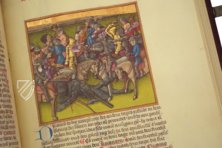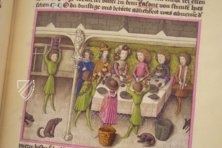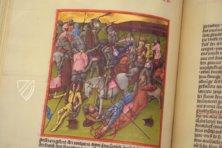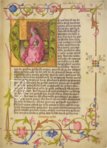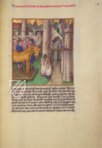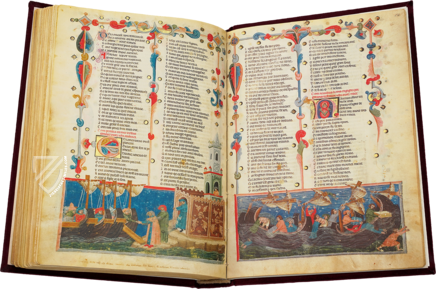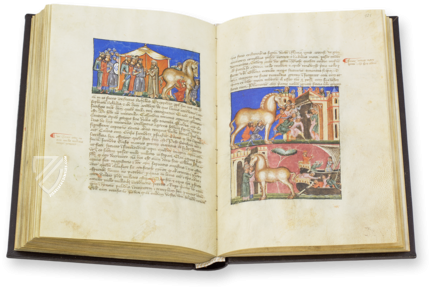Guido de Columnis: The Trojan War
(3,000€ - 7,000€)
Once owned by the Habsburg dynasty and now kept in the Austrian National Library in Vienna, this famous manuscript contains the most comprehensive surviving German language Trojan cycle. The manuscript, originating from Regensburg in the mid 15th century, presents an extensive German translation of the famous 13th century Latin epic by the Sicilian poet Guido de Columnis (1210–1290). The enthusiasm of medieval people for the legend of the fall of ancient Troy is evident in the magnificent miniatures and the captivating text. The manuscript transfers the mythological tale, which still fascinates and inspires today, into a 15th century environment, and thus the 334 captivating and often full-page miniatures by illuminator Martinus carry the beholder off into the world of late medieval courtly society, making it a valuable historical testimony.
Guido de Columnis: The Trojan War
Guido de Columnis (1210–1290) was a Sicilian poet from Messina. At the end of the 13th century, he wrote his most famous work, the Historia destructionis Troiae. This story about the destruction of Troy stands in the long tradition that has built itself around the mythological tale of the downfall of the ancient city. This material, Homer’s epic among others, was well-loved in the Middle Ages. For the impressive manuscript in the Austrian National Library, one has to reach back to the Latin original by Guido de Columnis, which was translated into German – albeit in the dialect of Bavaria and Austria. Thus the most-comprehensive German language Trojan cycle arose in a magnificent manuscript!
A Master from Regensburg
On 478 pages measuring 37 x 27.5 cm, the famous Cod. 2733 of the Austrian National Library in Vienna collects 334 miniatures, some even full-page. These magnificent paintings are richly embellished with gold and silver, once again highlighting the worth of the entire manuscript. The master responsible for these paintings was a miniaturist named Martinus. He immortalized himself in gold text on fol. 1r as martinus opifex. An unusual detail! One such illuminator named Martin was active in Regensburg during the middle of the 15th century, which allows conclusions to be made about the origins of the manuscript. In is believed among researchers that the manuscript of the work by Guido de Columnis was made in Regensburg in the years 1432–1456.
Courtly Life and Bloody Battles
The miniatures of the German translation of the work by Guido de Columnis offer a glimpse into the lifeworld of the 15th century. Gorgeous courtly scenes illustrate the tale of the downfall of Troy and the events associated with it. For example, a handsome procession of noble ladies and elegant noblemen, who ride out amidst a verdant green landscape, along with a court jester who rides together with an ape on a horse. Gothic architecture, e.g. a splendid doorway, surrounds some of the depictions. Yet, the painter did not shrink back from drastic depictions. A telling facial expression characterizes the brightly-dressed figures before an ornamental gold background.
Codicology
- Alternative Titles
- Guido de Columnis: Der Trojanische Krieg
Historia destructionis Troiae - Size / Format
- 478 pages / 37.0 × 27.5 cm
- Origin
- Germany
- Date
- 1432–1456
- Epochs
- Style
- Script
- Gothic Textura
- Illustrations
- 334 large-size miniatures (some of them full-page), richly decorated with gold and silver
- Content
- The most comprehensive German language Trojan cycle
- Artist / School
- Master Martinus
- Previous Owners
- Emperor Maximilian I (1459–1519)
Archduke Ferdinand II of Austria (1529–1595)
Guido de Columnis: The Trojan War
Shipbuilding
Helen of Troy’s beauty famously launched 10,000 ships and began the Trojan War. An army of shipbuilders was required in order to make this fleet possible, who are depicted here with childlike characteristics. Hammers in hand, they are shown driving nails into the side of a ship. The size of figures in medieval manuscripts was usually a reflection of their social stature, and as a result these commoners look childlike in comparison to the nobles who lazily watch their labor.

Guido de Columnis: The Trojan War
Wedding of Paris and Helen
The love between the Trojan prince Paris and the Spartan princess Helen was the catalyst for the bloodshed of the Trojan War. Amidst that tale of gods and men battling with one another, this is a scene of love and tranquility – the wedding of Paris and Helen, who was promised to Paris by the goddess Aphrodite.
The wedding is presented in the context of a Gothic cathedral, as witnessed through its pointed main doors. Both bride and groom are depicted as slender figures with thick, flowing locks of brown hair, small noses, pursed lips, and pink cheeks. Paris is dressed in a green tunic and tights while Helen has a long beautiful train of pink and gray. The Trojan king and queen, dressed in beautiful blue and gold brocade, flank the couple.

#1 Guido de Columnis: Der Trojanische Krieg
Language: German
(3,000€ - 7,000€)
#2 Guido de Columnis: Der Trojanische Krieg
Language: German
(3,000€ - 7,000€)
- Treatises / Secular Books
- Apocalypses / Beatus
- Astronomy / Astrology
- Bestiaries
- Bibles / Gospels
- Chronicles / History / Law
- Geography / Maps
- Saints' Lives
- Islam / Oriental
- Judaism / Hebrew
- Single Leaf Collections
- Leonardo da Vinci
- Literature / Poetry
- Liturgical Manuscripts
- Medicine / Botany / Alchemy
- Music
- Mythology / Prophecies
- Psalters
- Other Religious Books
- Games / Hunting
- Private Devotion Books
- Other Genres
- Afghanistan
- Armenia
- Austria
- Belgium
- Colombia
- Croatia
- Cyprus
- Czech Republic
- Denmark
- Egypt
- Ethiopia
- France
- Germany
- Greece
- Hungary
- India
- Iran
- Iraq
- Israel
- Italy
- Japan
- Lebanon
- Luxembourg
- Mexico
- Morocco
- Netherlands
- Palestine
- Peru
- Poland
- Portugal
- Russia
- Serbia
- Spain
- Sri Lanka
- Sweden
- Switzerland
- Syria
- Turkey
- Ukraine
- United Kingdom
- United States
- Uzbekistan
- Aboca Museum
- Ajuntament de Valencia
- Akademie Verlag
- Akademische Druck- u. Verlagsanstalt (ADEVA)
- Aldo Ausilio Editore - Bottega d’Erasmo
- Alecto Historical Editions
- Alkuin Verlag
- Almqvist & Wiksell
- Amilcare Pizzi
- Andreas & Andreas Verlagsbuchhandlung
- Archa 90
- Archiv Verlag
- Archivi Edizioni
- Arnold Verlag
- ARS
- Ars Magna
- ArtCodex
- AyN Ediciones
- Azimuth Editions
- Badenia Verlag
- Bärenreiter-Verlag
- Belser Verlag
- Belser Verlag / WK Wertkontor
- Benziger Verlag
- Bernardinum Wydawnictwo
- BiblioGemma
- Biblioteca Apostolica Vaticana (Vaticanstadt, Vaticanstadt)
- Bibliotheca Palatina Faksimile Verlag
- Bibliotheca Rara
- Boydell & Brewer
- Bramante Edizioni
- Bredius Genootschap
- Brepols Publishers
- British Library
- C. Weckesser
- Caixa Catalunya
- Canesi
- CAPSA, Ars Scriptoria
- Caratzas Brothers, Publishers
- Carus Verlag
- Casamassima Libri
- Chavane Verlag
- Christian Brandstätter Verlag
- Circulo Cientifico
- Club Bibliófilo Versol
- Club du Livre
- CM Editores
- Collegium Graphicum
- Collezione Apocrifa Da Vinci
- Comissão Nacional para as Comemorações dos Descobrimentos Portugueses
- Coron Verlag
- Corvina
- CTHS
- D. S. Brewer
- Damon
- De Agostini/UTET
- De Nederlandsche Boekhandel
- De Schutter
- Deuschle & Stemmle
- Deutscher Verlag für Kunstwissenschaft
- DIAMM
- Droz
- E. Schreiber Graphische Kunstanstalten
- Ediciones Boreal
- Ediciones Grial
- Ediclube
- Edições Inapa
- Edilan
- Editalia
- Edition Deuschle
- Edition Georg Popp
- Edition Leipzig
- Edition Libri Illustri
- Editiones Reales Sitios S. L.
- Éditions de l'Oiseau Lyre
- Editions Medicina Rara
- Editorial Casariego
- Editorial Mintzoa
- Editrice Antenore
- Editrice Velar
- Edizioni Edison
- Egeria, S.L.
- Eikon Editores
- Electa
- Emery Walker Limited
- Enciclopèdia Catalana
- Eos-Verlag
- Ephesus Publishing
- Ernst Battenberg
- Eugrammia Press
- Extraordinary Editions
- Fackelverlag
- Facsimila Art & Edition
- Facsimile Editions Ltd.
- Facsimilia Art & Edition Ebert KG
- Faksimile Verlag
- Feuermann Verlag
- Folger Shakespeare Library
- Franco Cosimo Panini Editore
- Friedrich Wittig Verlag
- Fundación Hullera Vasco-Leonesa
- G. Braziller
- Gabriele Mazzotta Editore
- Gebr. Mann Verlag
- Gesellschaft für graphische Industrie
- Getty Research Institute
- Giovanni Domenico de Rossi
- Giunti Editore
- Graffiti
- Grafica European Center of Fine Arts
- Guido Pressler
- Guillermo Blazquez
- Gustav Kiepenheuer
- H. N. Abrams
- Harrassowitz
- Helikon
- Hendrickson Publishers
- Henning Oppermann
- Herder Verlag
- Hes & De Graaf Publishers
- Hoepli
- Holbein-Verlag
- Hortus Deliciarum
- Houghton Library
- Hugo Schmidt Verlag
- Idion Verlag
- Il Bulino, edizioni d'arte
- ILte
- Imago
- Insel Verlag
- Instituto Nacional de Antropología e Historia
- Istituto dell'Enciclopedia Italiana - Treccani
- Istituto Ellenico di Studi Bizantini e Postbizantini
- Istituto Geografico De Agostini
- Istituto Poligrafico e Zecca dello Stato
- Italarte Art Establishments
- J. Thorbecke
- Jan Thorbecke Verlag
- Johnson Reprint Corporation
- Josef Stocker
- Josef Stocker-Schmid
- Jugoslavija
- Karl W. Hiersemann
- Kasper Straube
- Kaydeda Ediciones
- Kindler Verlag / Coron Verlag
- Kodansha International Ltd.
- Konrad Kölbl Verlag
- Kurt Wolff Verlag
- La Liberia dello Stato
- La Linea Editrice
- La Meta Editore
- Lambert Schneider
- Landeskreditbank Baden-Württemberg
- Leo S. Olschki
- Les Incunables
- Library of Congress
- Libreria Musicale Italiana
- Lichtdruck
- Lito Immagine Editore
- Lumen Artis
- Lund Humphries
- M. Moleiro Editor
- Maison des Sciences de l'homme et de la société de Poitiers
- Manuscriptum
- Martinus Nijhoff
- Maruzen-Yushodo Co. Ltd.
- MASA
- McGraw-Hill
- Militos
- Millennium Liber
- Müller & Schindler
- Nahar and Steimatzky
- National Library of Wales
- Neri Pozza
- Nova Charta
- Oceanum Verlag
- Odeon
- Orbis Mediaevalis
- Orbis Pictus
- Österreichische Staatsdruckerei
- Oxford University Press
- Pageant Books
- Parzellers Buchverlag
- Patrimonio Ediciones
- Pattloch Verlag
- PIAF
- Pieper Verlag
- Plon-Nourrit et cie
- Prestel Verlag
- Princeton University Press
- Prisma Verlag
- Priuli & Verlucca, editori
- Pro Sport Verlag
- Propyläen Verlag
- Pytheas Books
- Quaternio Verlag Luzern
- Reales Sitios
- Recht-Verlag
- Reichert Verlag
- Reichsdruckerei
- Riehn & Reusch
- Roberto Vattori Editore
- Rosenkilde and Bagger
- Roxburghe Club
- Salerno Editrice
- Sarajevo Svjetlost
- Schöck ArtPrint Kft.
- Scolar Press
- Scrinium
- Scripta Maneant
- Scriptorium
- Siloé, arte y bibliofilia
- SISMEL - Edizioni del Galluzzo
- Sociedad Mexicana de Antropología
- Société des Bibliophiles & Iconophiles de Belgique
- Soncin Publishing
- Sorli Ediciones
- Stainer and Bell
- Studer
- Styria Verlag
- Sumptibus Pragopress
- Szegedi Tudomànyegyetem
- Taberna Libraria
- Tarshish Books
- Taschen
- Tempus Libri
- Testimonio Compañía Editorial
- Thames and Hudson
- The Clear Vue Publishing Partnership Limited
- The Facsimile Codex
- The Folio Society
- The Marquess of Normanby
- The Richard III and Yorkist History Trust
- Tip.Le.Co
- TouchArt
- TREC Publishing House
- TRI Publishing Co.
- Trident Editore
- Typis Regiae Officinae Polygraphicae
- Union Verlag Berlin
- Universidad de Granada
- University of California Press
- University of Chicago Press
- Urs Graf
- Vallecchi
- Van Wijnen
- VCH, Acta Humaniora
- VDI Verlag
- VEB Deutscher Verlag für Musik
- Verlag Anton Pustet / Andreas Verlag
- Verlag Bibliophile Drucke Josef Stocker
- Verlag der Münchner Drucke
- Verlag für Regionalgeschichte
- Verlag Styria
- Vicent Garcia Editores
- W. Turnowsky
- Waanders Printers
- Wiener Mechitharisten-Congregation (Wien, Österreich)
- Wissenschaftliche Buchgesellschaft
- Wydawnictwo Dolnoslaskie
- Xuntanza Editorial
- Zakład Narodowy
- Zollikofer AG

